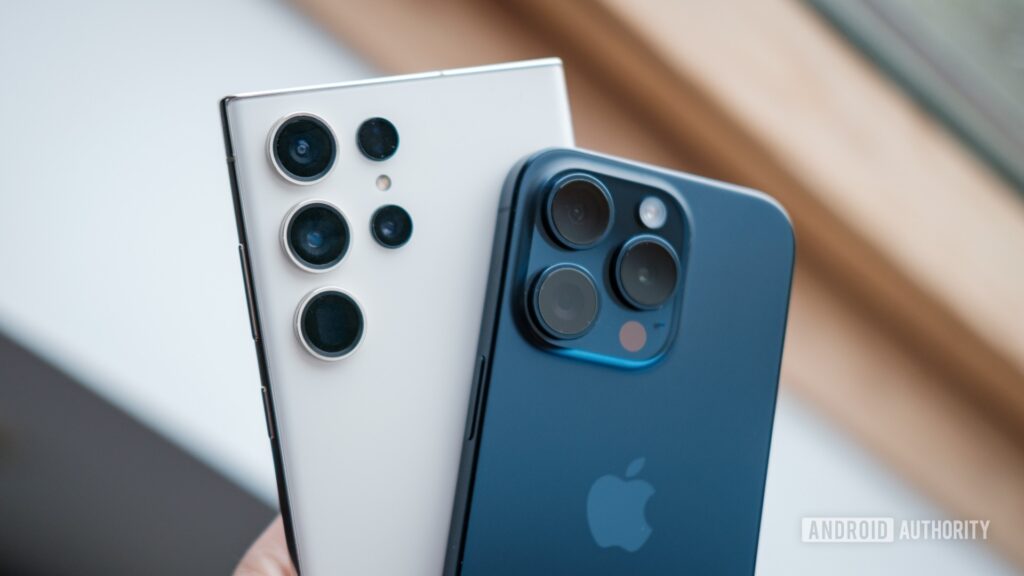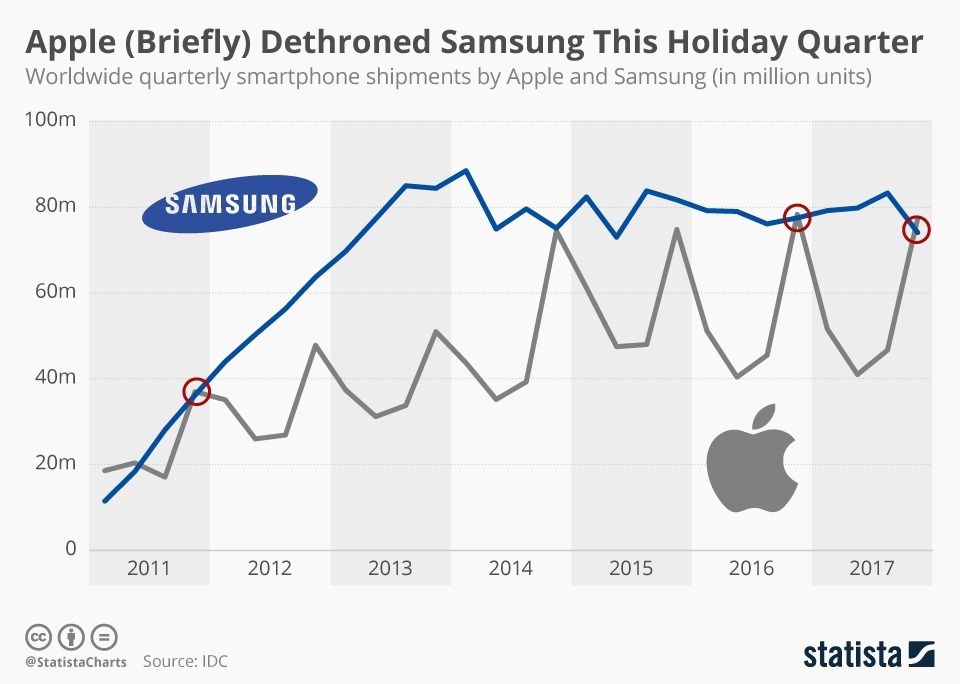Apple and Samsung are two of the biggest technology giants in the world, constantly competing across several sectors, including smartphones, semiconductors, and consumer electronics. However, recent trends have shown a divergence in their financial performances.
While Apple has faced declining revenue in certain areas, Samsung has experienced a significant boost. Understanding the factors behind Apple’s slowdown and Samsung’s rise provides insight into how market dynamics, product strategies, and technological innovations are reshaping the financial landscape of these two behemoths.
1. The Evolution of Apple’s Financial Status
Apple, once the most valuable company in the world, has built its reputation on innovation, premium pricing, and a dedicated user base. However, in recent years, Apple’s financial growth has hit some roadblocks.
1.1. The iPhone Saturation Point

The iPhone has been Apple’s golden goose for over a decade, accounting for a massive portion of its revenue. However, the global smartphone market has reached a point of saturation. Most markets, especially in developed countries, are seeing reduced demand for new smartphones as consumers hold onto their devices for longer periods.
- Advertisement -
New iPhone iterations tend to offer incremental updates rather than revolutionary changes, which makes it difficult to justify frequent upgrades. This trend has contributed to declining iPhone sales, affecting Apple’s financial status.
1.2. Competition from Other Brands
Competition from lower-priced Android phones, particularly from Chinese manufacturers like Xiaomi, Huawei, and Oppo, has chipped away at Apple’s market share. These companies offer high-spec devices at significantly lower prices, making it difficult for Apple to retain its dominance in key markets like China and India.
Additionally, Samsung’s strong presence in the premium and mid-range markets has directly impacted Apple’s revenue. Samsung’s Galaxy series, which competes directly with the iPhone, provides consumers with compelling alternatives, reducing Apple’s grip on the high-end smartphone market.
1.3. Slowing Innovation
Critics have often pointed out that Apple’s innovation has plateaued. The company has traditionally thrived on groundbreaking products—like the iPod, iPhone, and iPad—but in recent years, Apple has been seen more as a follower than a leader in tech innovation. Features like 5G integration, foldable phones, and even display technology have been pioneered by competitors such as Samsung, leaving Apple to play catch-up.
While Apple is investing heavily in augmented reality (AR) and autonomous driving, these projects are still in development phases and have yet to contribute to its financial growth.
2. Samsung’s Financial Growth

While Apple is grappling with these challenges, Samsung has seen significant financial success, particularly in the past few years.
2.1. Diverse Product Portfolio
One of the main reasons for Samsung’s rise is its diversified product portfolio. Unlike Apple, which relies heavily on the iPhone for revenue, Samsung is a major player in multiple industries, including semiconductors, display technology, home appliances, and more. This diversification has allowed Samsung to weather market fluctuations better than Apple.
For instance, Samsung is the world leader in memory chips and semiconductors, a market that has seen immense growth due to the increasing demand for computing power, data centers, and 5G technology. Samsung’s semiconductor division has become a critical source of revenue, contributing to the company’s strong financial performance.
2.2. Market Leadership in Display Technology
Samsung is also a global leader in display technology. Its OLED (Organic Light Emitting Diode) screens are widely regarded as the best in the industry and are used in smartphones, televisions, and even Apple products. In fact, Apple is one of Samsung’s biggest customers for OLED displays, used in the iPhone X and later models.
This vertical integration allows Samsung to maintain cost advantages and dominate both the supply chain and end-market. Samsung’s leadership in display technology has given it a financial edge that Apple does not possess.
2.3. Innovation and Adaptability
Unlike Apple, Samsung has embraced innovation in key areas such as foldable smartphones. The Galaxy Z Fold and Galaxy Z Flip series have been widely praised for their innovation, offering users a unique experience that differentiates Samsung from its competitors. While these devices are still niche, they represent Samsung’s willingness to take risks and invest in the future of mobile technology.
Additionally, Samsung has been quicker to adopt and integrate emerging technologies like 5G, AI, and the Internet of Things (IoT) across its product lines, contributing to its financial growth.
2.4. Dominance in the Smartphone Market
While Apple remains strong in the premium smartphone market, Samsung has successfully captured a broader range of price points. From high-end flagship models like the Galaxy S and Note series to more affordable models like the Galaxy A and M series, Samsung caters to a wider audience, especially in emerging markets.
This breadth has allowed Samsung to maintain its position as the world’s largest smartphone maker by volume, ensuring steady revenue growth.
3. External Market Forces Impacting Apple and Samsung
3.1. Supply Chain Disruptions
Both Apple and Samsung have been impacted by the global semiconductor shortage and supply chain disruptions. However, Samsung’s vertical integration in the semiconductor market has allowed it to mitigate some of these risks better than Apple. While Apple relies on third-party suppliers like Taiwan’s TSMC for chips, Samsung manufactures its own, giving it a strategic advantage during periods of global shortages.
3.2. Global Trade Policies
Trade wars, tariffs, and international relations have also played a significant role in shaping the financial trajectories of both companies. Apple, for instance, has faced challenges due to the U.S.-China trade war, which has impacted its supply chain and sales in China, one of its largest markets.
Samsung, being a South Korean company, has been less affected by U.S.-China tensions, allowing it to navigate global trade policies with more flexibility.
4. Apple’s Strategic Shifts to Counter Financial Decline
While Apple has faced setbacks, the company is not resting on its laurels. Several strategic shifts are underway to revive its financial performance.
4.1. Focus on Services
Apple has been transitioning from a hardware-centric company to one focused on services. The company’s services division, which includes iCloud, Apple Music, Apple TV+, and the App Store, has been growing steadily and now contributes a significant portion of Apple’s revenue.
This recurring revenue model provides more stability than hardware sales, which are cyclical. Apple’s push into subscription-based services is an attempt to counterbalance slowing iPhone sales and ensure long-term financial sustainability.
4.2. Wearables and Health Tech
Apple’s wearables division, including products like the Apple Watch and AirPods, has been a bright spot in the company’s financials. The Apple Watch, in particular, has become a leader in the health and fitness tech space, offering features like heart rate monitoring, ECG capabilities, and fall detection.
Apple’s investment in health tech is a strategic move to diversify its product portfolio and tap into a growing market.
5. The Future Outlook for Apple and Samsung
5.1. Apple’s Prospects
Despite its recent financial struggles, Apple remains one of the most valuable companies in the world. Its loyal customer base, strong brand identity, and growing services division provide a solid foundation for future growth. However, Apple will need to accelerate its pace of innovation, particularly in areas like AR, AI, and health tech, to regain its financial momentum.
5.2. Samsung’s Prospects
Samsung, on the other hand, is well-positioned for continued growth. Its leadership in semiconductors, display technology, and consumer electronics, combined with its willingness to innovate, gives it a strong competitive advantage. As long as Samsung continues to diversify its revenue streams and invest in emerging technologies, it will likely maintain its financial upward trajectory.
Apple And Samsung
The contrasting financial trajectories of Apple and Samsung highlight the importance of innovation, diversification, and adaptability in the tech industry. While Apple faces challenges due to iPhone saturation and slowing innovation, Samsung’s diversified portfolio and leadership in key technologies have enabled it to thrive. However, both companies are making strategic shifts to position themselves for future success in an ever-evolving market.

